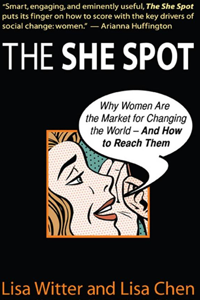 Driving into work today I heard a radio spot sponsored by American Express. It featured the Smart Cookies, five women who got together to get their finances under control. Andrea was struggling with debt; Angela was addicted to her credit card; Katie let shopping sprees and bills get the best of her; Robin was trying to make the most of a low-paying job; Sandra was afraid to manage her own money. After two years of education and peer counseling – so the story goes – all five women are now “on the road to financial recovery.” They’re also making lots of dough telling their story via multiple media outlets, including Oprah!
Driving into work today I heard a radio spot sponsored by American Express. It featured the Smart Cookies, five women who got together to get their finances under control. Andrea was struggling with debt; Angela was addicted to her credit card; Katie let shopping sprees and bills get the best of her; Robin was trying to make the most of a low-paying job; Sandra was afraid to manage her own money. After two years of education and peer counseling – so the story goes – all five women are now “on the road to financial recovery.” They’re also making lots of dough telling their story via multiple media outlets, including Oprah!
Call American Express self-serving. Call them insincere. But also call them smart. By fueling a full-scale marketing campaign with women, for women, Amex is transforming a traditionally male-focused industry – financial services – into an accessible arena for women. And they’re likely to see their profits increase from connecting with one of the biggest consumer markets in the U.S. – women.
An article and two recent books make the case that women, not men, have become the most vital market segment to reach, not only for consumer brands but for nonprofit organizations that seek to change the world.
segment to reach, not only for consumer brands but for nonprofit organizations that seek to change the world.
In part one of this two-part blog post, I’ll make the case that women are the market for changing the world and suggest ways to connect with them. In part two I’ll show you where to find them.
Why Market to Women?
Consider the following facts:
- Women bring in half or more of the income in 55 percent of U.S. households, according to Marti Barletta in “Big Economic Opportunity in Marketing to Women.” Women also function as “Chief Purchasing Officer” in almost all households and are estimated to make 80 percent of all household buying decisions, including in such traditionally male categories as investments, automotive, consumer electronics and home improvement.
- “Women make contributions to twice as many charitable organizations as men do, and they are more likely to take greater risks in organizations with a strong vision for change,” according to Lisa Witter and Lisa Chen, co-authors of The She Spot: Why Women are the Market for Changing the World and How to Reach Them. “Even more striking, high-net worth women business owners with assets of more than $1 million are even more likely than their male counterparts to contribute at least $10,000 a year to charity (50 percent for women compared to 40 percent for men),” the authors say.
- Women also volunteer much more than men do. Thirty-two percent of women, compared to just 25 percent of men, volunteer across every state, age group and education level. The typical American volunteer is reportedly a female who gives 50 hours of her time per year. Not surprisingly, Witter and Chen urge nonprofits to follow the lead of big consumer brands and get a handle on this powerful demographic shift by re-targeting their marketing efforts to attract more women donors, members, volunteers and advocates.
Finally, according to Andrea Learned, another expert in marketing to women and co-author of Don’t Think Pink, as the ranks of affluent women increase, two-thirds of all private wealth in the U. S. will soon be in women’s hands.
Let me say that again. In the near future, women will control two-thirds of all wealth in the U.S.!
Hopefully I’ve piqued your interest in the potential of women’s giving. If so, it’s up to you to figure out how to connect more women to your cause. Here are some ideas.
How to Market to Women:
Step 1: Do a demographic append and analyze your house file to determine how many women are already connected to your cause. Use this information to make a case (or not) for tailoring your marketing efforts to target more women donors, members and volunteers.
Step 2: Make your marketing, particularly your website, more accessible.
- Tell stories. A lot has been said in recent years about the power of stories to persuade and storytelling as a device may be even more powerful for women who tend toward right-brained thinking. Right-brainers place an emphasis on feelings. They tend to focus on the “big picture,” rely on imagination, symbols and images. This compares to left-brained thinkers who tend to be logical, detail-oriented and methodical. In short, storytelling is a great way to get women emotionally connected to your cause. The good news for nonprofits is that emotions are our stock in trade.
- Be transparent. According to Witter and Chen, women are more exacting consumers than men. They’re used to checking labels and comparing prices. So be sure to give them detailed information about how you’ll spend their money. By the way, you don’t have to do this by taking women through a dry overview of your statistics. (See point above). Instead, you can use images and graphics to paint a picture of where you’ve been and where you’re headed. You can also get other donors or program recipients to show the impact of your success for you. For example, similar to Yelp or Zagats, Great Nonprofits is a site that lets people review and talk about nonprofits. Ask your best donors, volunteers and members to rate your charity on their site and then link to their reviews.
- Put women in control. If you do nothing else for the women (and men) who support you, make is EASY for them to connect with you and your work. De-clutter your website. Offer lots of opportunities to get involved. Suggest text that they can repurpose and share with friends. In short, make your cause about her, not you!
Step 3: Find a way to connect your female stakeholders to each other.
As a value add, many nonprofits are finding ways to connect women to each other to communicate and organize online. While this might require additional staff time, it makes a lot of sense in the long term. For example, nonprofits are using social networking sites and other online tools such as forums to connect their members and stakeholders to one another. By making a space online for women who love your organization to share that passion with their friends and family, you get to leverage their networks to find new stakeholders and keep them loyal.
Click here for part two and learn where your nonprofit can find and connect with women.
*Jocelyn Harmon is the Director of NonProfit Services at Care2.com
You should follow Frogloop on Twitter.


COMMENTS